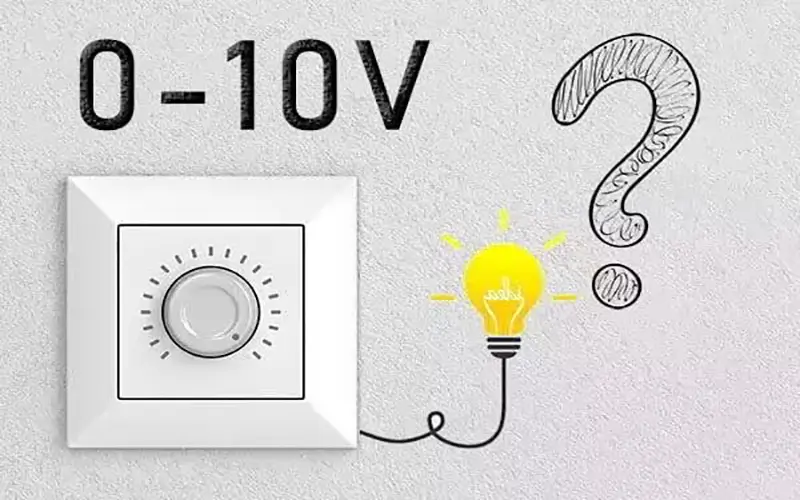
Dimming is an innovative and flexible way to control light. LED lighting is an important part of the lighting market and can be dimmed or brightened according to your mood. 0-10V dimming is a method of dimming analog lighting fixtures that uses a control voltage signal to adjust the light output from 0% to 100%. Unlike TRIAC dimmers, which dim the light via a TRIAC component on the high-voltage side, 0-10V dimmers vary the intensity of dimmable lamps such as LED strip lights, fluorescent lamps, and.
As one of the three major dimming types, 0-10V dimmer is also one of the common methods for commercial and industrial lighting. What are the advantages of using 0-10V dimming? Is it suitable for your lighting project? This beginner’s guide provides all the information you need to know about 0 to 10V dimmers and 0-10V dimming.
What is 0-10V Dimming?
0-10V dimming is a lighting control system. In the past, this dimming technology was mainly used on fluorescent lamps. Now it is also used in LED lamps. It operates at a direct current voltage (DC) between 0 and 10 volts. The easiest way to control lighting is to use 0-10V dimming, which allows for smooth operation and dimming down to 10%, 1% or even 0.1%.
The light will be brightest at 10 volts. 0 volts means the light is off or the minimum dimming level, but sometimes a switch is needed to turn it off completely. In a 1-10V dimming system, 1 volt represents the lowest brightness level). The 0-10V dimmer will adjust the output voltage according to the received voltage signal to control the brightness of the light.
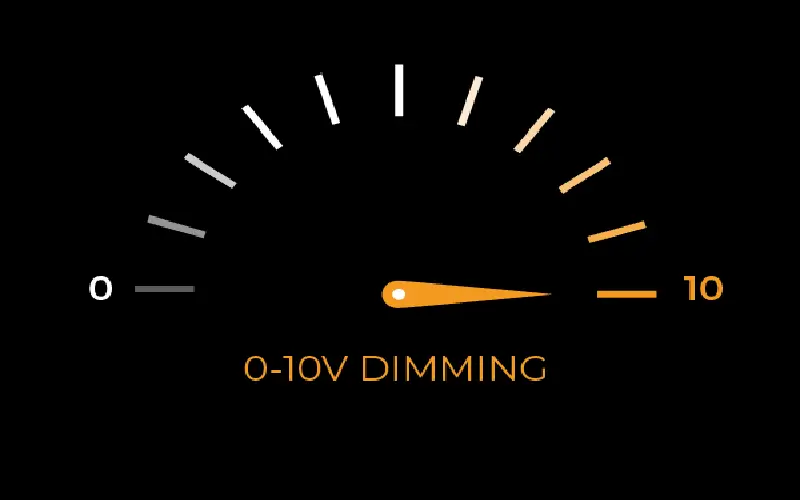
What is a 0-10V Dimmer?
0-10V dimmer is an electronic dimming device, mainly used to control the brightness of dimmable lights. When you use a 0-10V power supply and can connect a dimmer switch, remote control or smart home system, your operation will be converted into a dimming signal and received by the 0-10V controller.
The 0-10V controller converts the received dimming signal into a 0-10V voltage signal and then sends it to the 0-10V driver. The driver receives the signal and adjusts the light intensity of the fixture to the appropriate level. The 0~10V dimmer converts the dimming signal into a signal that the lighting device can understand, thereby controlling the brightness of the light.
How Does A 0-10V Dimming System Work?
An LED driver with 0-10V dimming function needs to be paired with a 0-10V dimmer so that the LED strip can work properly. The 0-10V power supply has a circuit with purple and gray wires that produces a 10V DC signal.
Typically, the DC voltage matches the driver’s dimming level. For example, if the signal is 8V, the fixture is at 80% output. If the signal is turned down to 0V, the light is at its darkest level, probably between 10% and 1%.
0-10V Dimmer with AC Input
A 0-10V dimmer usually needs some power supply to work, and this power supply can be AC or DC. Therefore, even if the LED dimmer is based on a 0-10V dimming system, it still needs some power to operate.

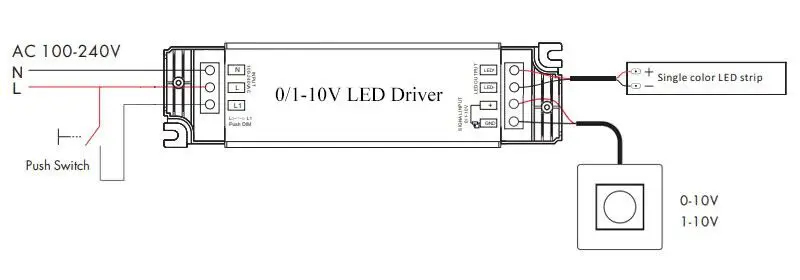
0-10V Dimmer With DC Input
When the 0-10V LED dimmer is tuned to the lowest brightness level, the output of the dimming signal should be 0V. This signal is sent to the 0-10V dimmer and converted to a 0V output voltage. After the 0-10V driver receives the 0V input signal, it adjusts the LED brightness to the lowest level.
Therefore, when the 0-10V dimmer switch is set to the lowest brightness level, the LED brightness will also be adjusted to the lowest level. And when the 0-10V LED dimmer is tuned to the highest brightness level, the 10V dimming signal is converted to 10V input voltage and accepted by the driver, resulting in the LED light strip reaching the highest brightness level.
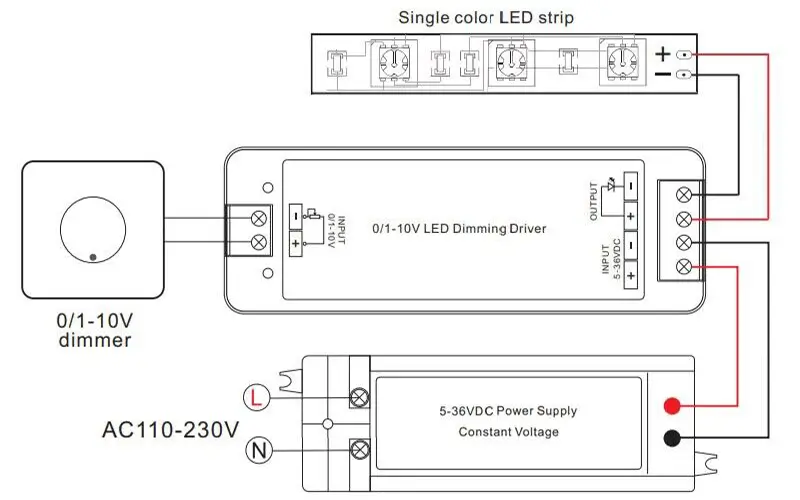
Why Do You Need a 0-10V Dimmer?
It was adopted as the standard way of controlling fluorescent lamps with dimming ballasts and is still commonly used. Compared with TRIAC dimming or electronic dimming, 0-10V dimming can achieve a more delicate dimming effect without problems such as flickering or color distortion.
It can also be used in outdoor commercial applications requiring a variety of lighting purposes. And you can connect a variety of lighting devices, as long as they are compatible.
0-10V Dimming vs. Other Dimming Systems
There are many types of dimming systems available in the lighting industry, each with its own advantages and disadvantages. You can make a choice based on your own situation.
- 1: 0-10V dimming is a simple and widely used analog dimming technology that is compatible with many lighting fixtures and control systems, but the control range is very limited and is susceptible to interference and noise.
- 2: DALI allows for precise and individual control of each lighting fixture, but installation and operation can be more complex and expensive than other systems. You need to consider the cost.
- 3: PWM provides flicker-free and efficient dimming for LED lighting applications, but may require special control equipment. Wireless systems are flexible and easy to install but can be susceptible to interference and hacker attacks.
- 4: TRIAC dimming is simple and inexpensive, but can produce an audible hum or hum.
- 5: DMX provides flexible programmable control, but it requires specialized control equipment and the cost is quite high.

How to Install a 0-10V Dimming System?
Here are the steps to install a 0-10V dimming system:
- Materials to prepare: You will need a 0-10V dimmer driver, a dimmer switch to use with the driver, and LED strips to use with the dimmer system.
- Turn off the power: Before starting the installation, turn off the power to the circuits you will be using.
- Connect the power supply and LED lights to the dimming driver.
- Connect the dimmer switch to the driver for dimming.
- Check whether the system is working properly.
When installing, you must make sure to follow all safety rules and instructions for your equipment. If you have any questions, please contact the supplier in time.
What are the Benefits and Limitations of 0-10v dimming?
Let’s discuss specifically why you should choose 0-10V dimming. and the Benefits and Limitations of 0-10v dimming.
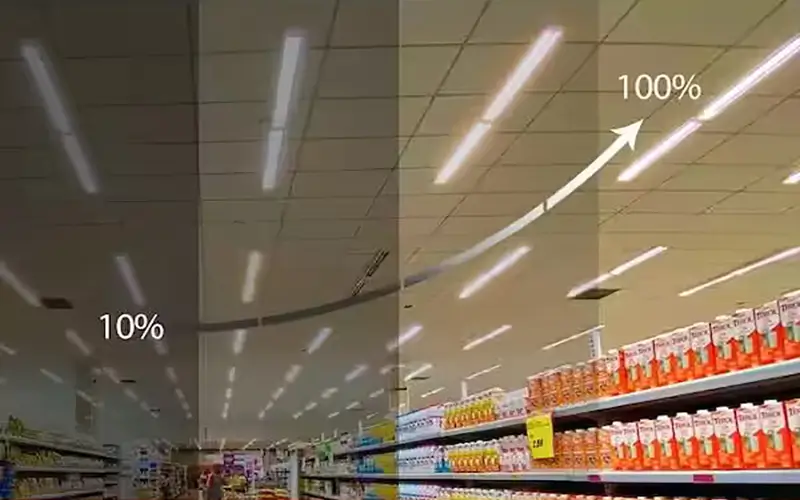
Benefits of 0-10V dimming
- This is a proven technology paired with LEDs.
- It’s easy to install and use, and one of the easiest ways to reduce your electricity usage.
- It’s perfect for outdoor business events where the lights need to be dimmed.
- Its input voltage is proportional to the output brightness. It is a linear dimming method, which means it can provide users with a smooth dimming effect to precisely control the brightness of the lamp.
- At present, 0-10V dimming has been standardized, is compatible with various types of lamps and controllers, and can be easily combined and replaced.
Limitations of 0-10V dimming
- It is a bit difficult to combine the 0-10V dimming system with the primary dimming system.
- At present, there are not many companies that make 0-10V dimming, and it is difficult to find good quality products.
- Although 0-10V dimming can provide a linear dimming effect, it may cause LED lights to flicker or have unstable brightness at low brightness.
- 0-10V dimming requires two wires, a control signal, and a power signal. There are wiring limitations during installation that may require additional cost and time.
- When the 0-10V dimming control voltage is significantly different from the power supply voltage, the control range may be limited.
What Do I Need For 0-10V Dimming?
Because of how LEDs work and how some drivers are made. Be aware that not all LED power supplies can be used with 0-10V dimmers. It is crucial that you make sure your light fixture has the right parts for the dimmer to work.
In some cases, to make an existing fixture dimmable, you can simply turn off the driver. LED technology has come a long way in recent years, and most commercial LED fixtures are now dimmable. Once you know if your light fixture is compatible, you will need to run the low-voltage wiring from the light fixture back to the compatible wall switch.
Summary
I believe you now have an understanding of 0-10V dimming. It is a method of controlling the brightness of lamps by sending a low-voltage signal. This dimming method is simple and reliable, and it works well with many different types of lighting, such as LEDs, fluorescents, and incandescents. It can be used anywhere from small residential projects to large commercial facilities.
If you’re looking for a simple and easy-to-operate solution to control lighting brightness, then 0-10V dimming may be your best choice. Compared to other methods of dimming lights, they are relatively inexpensive to set up and maintain. It is also easy to install, making it a great choice for upgrading your existing lighting system.
We manufacture high-quality LED strip lights and LED neon strips. All our products come with a 5-year warranty and free samples for testing to ensure the highest quality. If necessary, please contact us as soon as possible!
FAQs
The main difference is the control voltage range. With 0-10V dimming, the voltage range is 0 to 10V, while with 1-10V dimming, the voltage range starts at 1V and goes up to 10V. Both systems are analog dimming methods used to control the brightness of compatible lighting fixtures.
The three main types of dimmers are resistive (used in incandescent lamps), capacitive (used in low-voltage halogen lamps), and inductive (used in magnetic low-voltage transformers and LED drivers). You need to choose according to your needs.
The wattage capacity of the 0-10V dimmer is determined by the power of the power supply. Typically, 0-10V dimmers are available in 100W, 150W, or even higher depending on whether it is used for incandescent, fluorescent or LED lighting.
Using a dimmer on a non-dimmable light can cause flickering, buzzing, reduced bulb life, or even damage to the dimmer or light. It is therefore necessary to use dimmable lamps with dimmer switches designed for the specific lighting technology.
No, regular dimmers designed for resistive loads (such as incandescent light bulbs) are not suitable for 0-10V dimming. You will need a dedicated 0-10V dimmer designed to work with the control signals used in 0-10V dimming systems.
0-10V dimming is typically associated with direct current (DC) systems. The control signal sent to the lighting fixture is a low-voltage DC signal, while the power supplied to the lamp can be AC or DC, depending on the application.
